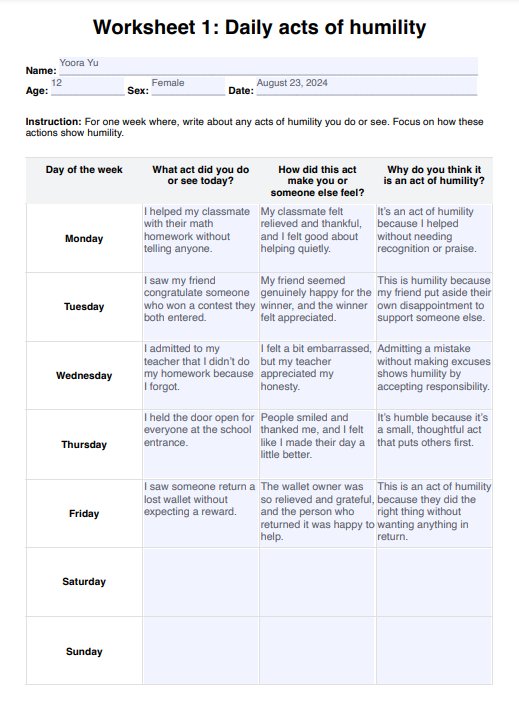Humility Worksheets PDF
Teach children humility with this character education resource. Download our Humility Worksheets PDF to enhance sessions and classroom activities.


What is a humility worksheet?
Teaching individuals essential character traits is one of the salient features of character education to build good character. There are many character traits, and learning them early in life can shape a person's life and relationships. Some basic ones taught primarily to school students include generosity, gratitude, forgiveness, honesty, and humility. The last character trait mentioned is humility, which is vital to personal growth, self-confidence, and self-esteem.
Humility, as defined by the American Psychological Association (2018), is the "quality of being humble, characterized by a low focus on the self, an accurate (not over- or underestimated) sense of one's accomplishments and worth, and an acknowledgment of one's limitations, imperfections, mistakes, gaps in knowledge, and so on." With all of these encapsulating humility, it goes without saying that cultivating this trait doesn't happen overnight. Teachers, counselors, and parents can use resources like humility worksheets to instill this trait in young people.
Humility worksheets are often created for kids or teens to help them understand and practice humility. Inclusive are activities, questions, and exercises that encourage reflection on one's actions, thoughts, and attitudes. Our worksheets consist of the following:
- Daily acts of humility: The worksheet lets them track and reflect on acts they do or see each day.
- Learning from the best: They identify role models who show humility through their actions and stories.
- What would you do?: They are prompted to imagine how they would handle situations where humility is key.
- Self-check: How humble am I?: This worksheet lets students assess their humility by rating different statements and reflecting on their behavior.
- Gratitude and humility art project: Students create a piece of art that reflects something they are grateful for and how it relates to humility.
The worksheets aim to help recognize their strengths and weaknesses, appreciate others, and develop a balanced sense of self without arrogance.
Humility Worksheets PDF Template
Humility Worksheets PDF Example
How to use our Humility Worksheets PDF template
Our Humility Worksheets PDF resource includes humility activities you can use when your session calls for a lesson or discussion on humility. Here are the steps to use the worksheet:
Step 1: Download the worksheet
Get the worksheet by clicking on the download button on this page. Once you get a hold of our Humility Worksheets PDF, you can print them or save a digital copy. You can also access this if you have a Carepatron account.
Step 2: Explain the purpose and contents of the worksheet
Our template comprises five worksheets crafted to make humility discussions and lessons fun and engaging. You can explain the purpose of each as well as provide instructions on how clients can accomplish them.
Step 3: Have your clients answer the activities
Once they understand how to do the worksheets, distribute them and have users answer questions, activities, and exercises. Since we have five worksheets, you can assign one for each session so that it will not overwhelm them. Be available to assist them when they need clarity regarding instructions.
Step 4: Give them time to reflect and discuss their answers
After answering the worksheet, encourage them to review and reflect on their answers. This is an excellent starting point for letting them discover the importance of this specific trait in their daily lives. Help them process their answers so they can gradually grasp and imbibe humility, starting with small acts.
When to use these worksheets
We've established that worksheets are a fun and engaging way to teach a character trait. To be specific, here are some instances where they are most valuable:
Counseling or therapy sessions
Counselors can use a humility worksheet during one-on-one or group counseling sessions to address issues like bullying, social conflicts, or self-esteem challenges. These will guide students toward a more empathetic and humble behavior when encountering unexpected tumbles.
Classroom activities
Values education teachers can integrate a humility worksheet into classroom activities coupled with a ready-to-use lesson when they reach the humility unit of their lesson plan. Since one of the worksheets involves self-assessment, it will help students reflect on their actions and interactions with peers.
Group activities or workshops
Humility worksheets can be used in leadership programs, character-building workshops, or Bible study sessions. Our worksheets assist students in understanding the importance of staying grounded in their personal growth, teamwork, and spiritual development.
References
American Psychological Association. (2018, April 19). Humility. https://dictionary.apa.org/humility
Commonly asked questions
Encourage self-reflection and empathy in adults to teach them humility. Help them understand the value of acknowledging their limitations and appreciating others' contributions.
Five ways to be humble include listening to others without interrupting, admitting mistakes, showing gratitude, valuing others' opinions, and putting others' needs before yours.
Practicing humility can improve mental health by reducing self-centered thoughts and promoting a balanced view of oneself. This can lead to lower stress, better relationships, and a more positive outlook on life.





















-template.jpg)


















































































